Identifying and Analyzing Variables in Business Research
VerifiedAdded on 2021/06/17
|5
|1164
|38
Report
AI Summary
This report provides an analysis of the dependent, independent, moderating, mediating, and controlling variables within a business research context. It defines these variables, illustrating their interrelationships through examples such as the impact of training on employee retention, and the role of organizational culture. The report explores the motivation for including these variables in a conceptual framework, highlighting recent studies that emphasize the importance of utilizing and retaining skilled employees for organizational success. It explains how these variables are measured, referencing the methodology of a study involving expert interviews, national surveys, and case studies. Furthermore, the report identifies additional significant variables, including sample and extraneous variables, and discusses the importance of moderator variables in determining the extent of the association between dependent and independent variables. References from various academic sources are included to support the analysis.
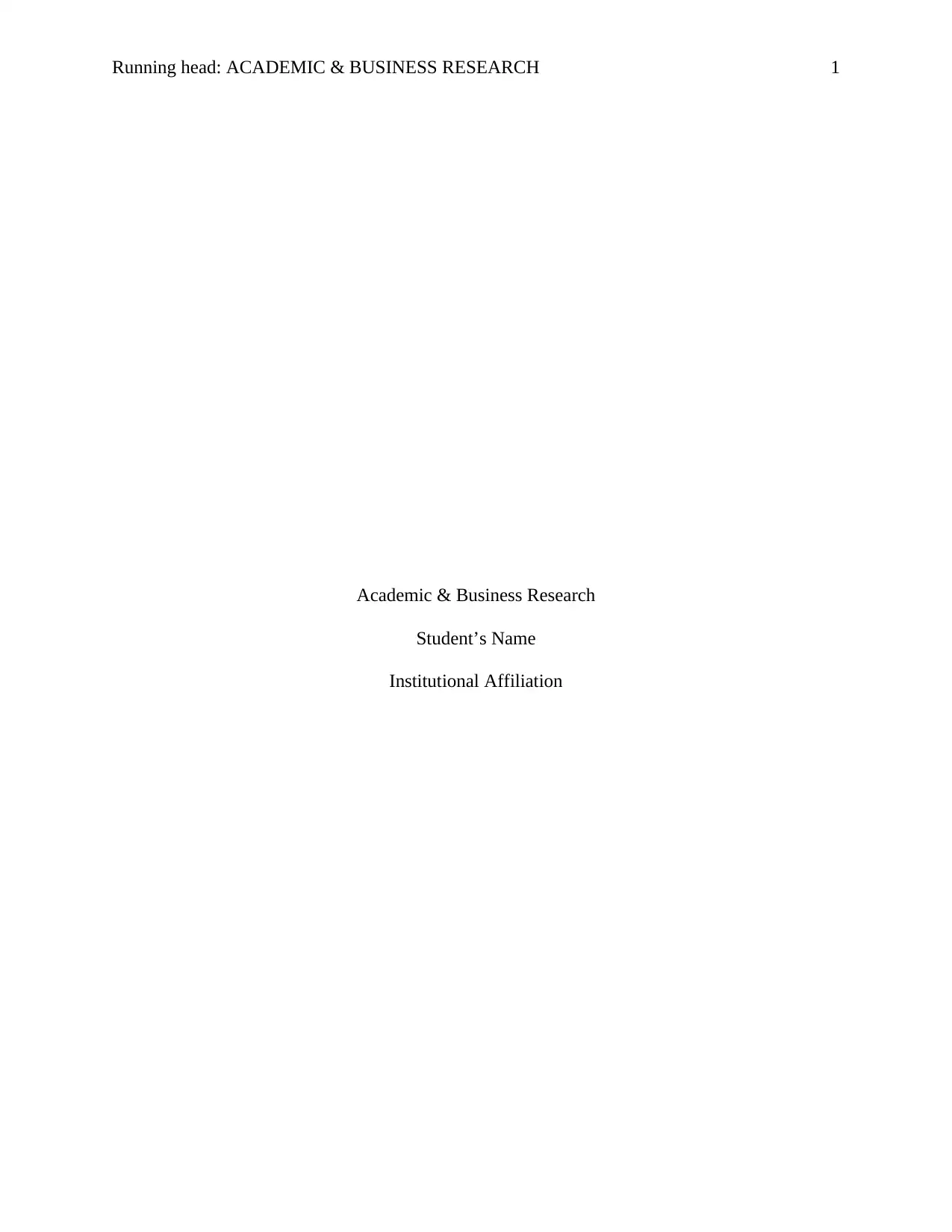
Running head: ACADEMIC & BUSINESS RESEARCH 1
Academic & Business Research
Student’s Name
Institutional Affiliation
Academic & Business Research
Student’s Name
Institutional Affiliation
Paraphrase This Document
Need a fresh take? Get an instant paraphrase of this document with our AI Paraphraser
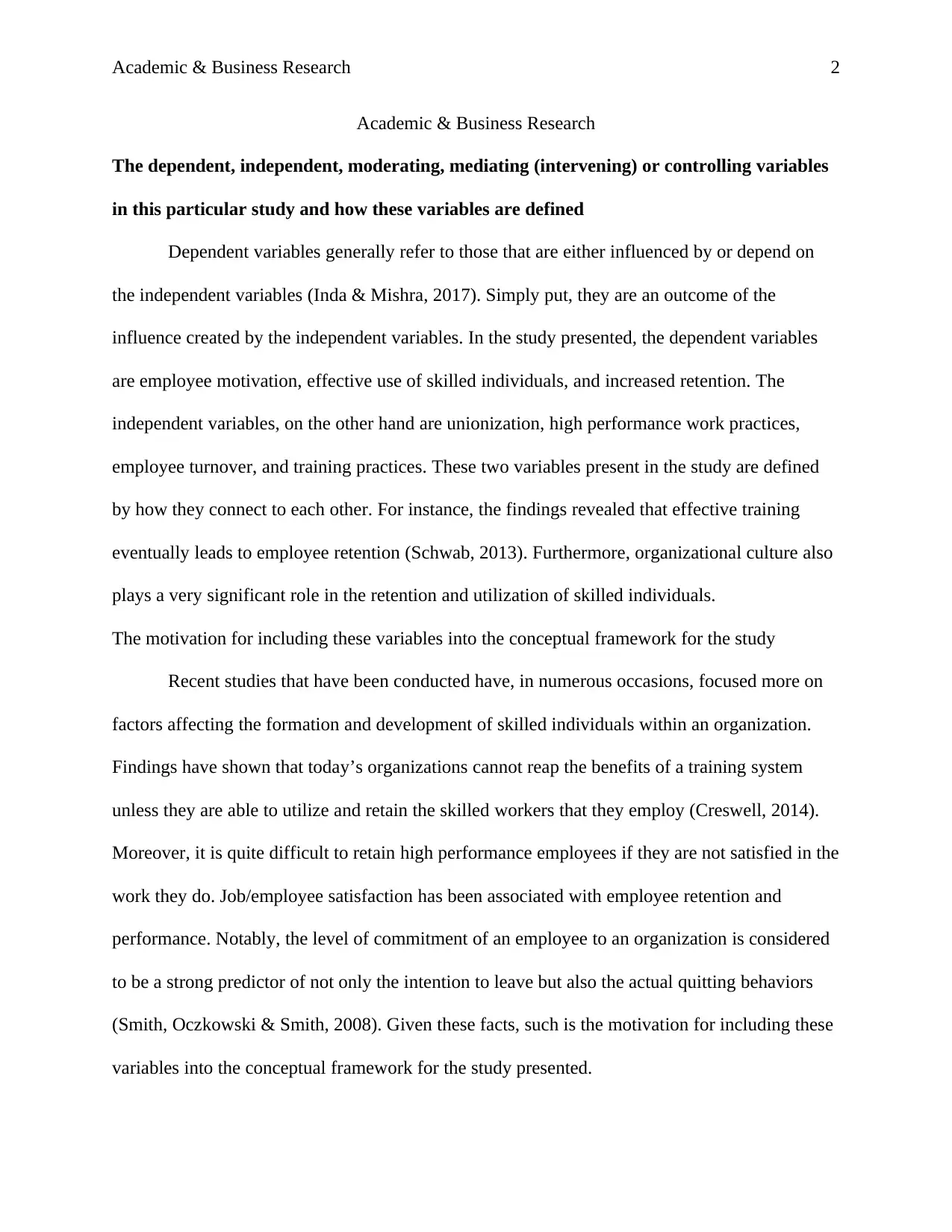
Academic & Business Research 2
Academic & Business Research
The dependent, independent, moderating, mediating (intervening) or controlling variables
in this particular study and how these variables are defined
Dependent variables generally refer to those that are either influenced by or depend on
the independent variables (Inda & Mishra, 2017). Simply put, they are an outcome of the
influence created by the independent variables. In the study presented, the dependent variables
are employee motivation, effective use of skilled individuals, and increased retention. The
independent variables, on the other hand are unionization, high performance work practices,
employee turnover, and training practices. These two variables present in the study are defined
by how they connect to each other. For instance, the findings revealed that effective training
eventually leads to employee retention (Schwab, 2013). Furthermore, organizational culture also
plays a very significant role in the retention and utilization of skilled individuals.
The motivation for including these variables into the conceptual framework for the study
Recent studies that have been conducted have, in numerous occasions, focused more on
factors affecting the formation and development of skilled individuals within an organization.
Findings have shown that today’s organizations cannot reap the benefits of a training system
unless they are able to utilize and retain the skilled workers that they employ (Creswell, 2014).
Moreover, it is quite difficult to retain high performance employees if they are not satisfied in the
work they do. Job/employee satisfaction has been associated with employee retention and
performance. Notably, the level of commitment of an employee to an organization is considered
to be a strong predictor of not only the intention to leave but also the actual quitting behaviors
(Smith, Oczkowski & Smith, 2008). Given these facts, such is the motivation for including these
variables into the conceptual framework for the study presented.
Academic & Business Research
The dependent, independent, moderating, mediating (intervening) or controlling variables
in this particular study and how these variables are defined
Dependent variables generally refer to those that are either influenced by or depend on
the independent variables (Inda & Mishra, 2017). Simply put, they are an outcome of the
influence created by the independent variables. In the study presented, the dependent variables
are employee motivation, effective use of skilled individuals, and increased retention. The
independent variables, on the other hand are unionization, high performance work practices,
employee turnover, and training practices. These two variables present in the study are defined
by how they connect to each other. For instance, the findings revealed that effective training
eventually leads to employee retention (Schwab, 2013). Furthermore, organizational culture also
plays a very significant role in the retention and utilization of skilled individuals.
The motivation for including these variables into the conceptual framework for the study
Recent studies that have been conducted have, in numerous occasions, focused more on
factors affecting the formation and development of skilled individuals within an organization.
Findings have shown that today’s organizations cannot reap the benefits of a training system
unless they are able to utilize and retain the skilled workers that they employ (Creswell, 2014).
Moreover, it is quite difficult to retain high performance employees if they are not satisfied in the
work they do. Job/employee satisfaction has been associated with employee retention and
performance. Notably, the level of commitment of an employee to an organization is considered
to be a strong predictor of not only the intention to leave but also the actual quitting behaviors
(Smith, Oczkowski & Smith, 2008). Given these facts, such is the motivation for including these
variables into the conceptual framework for the study presented.
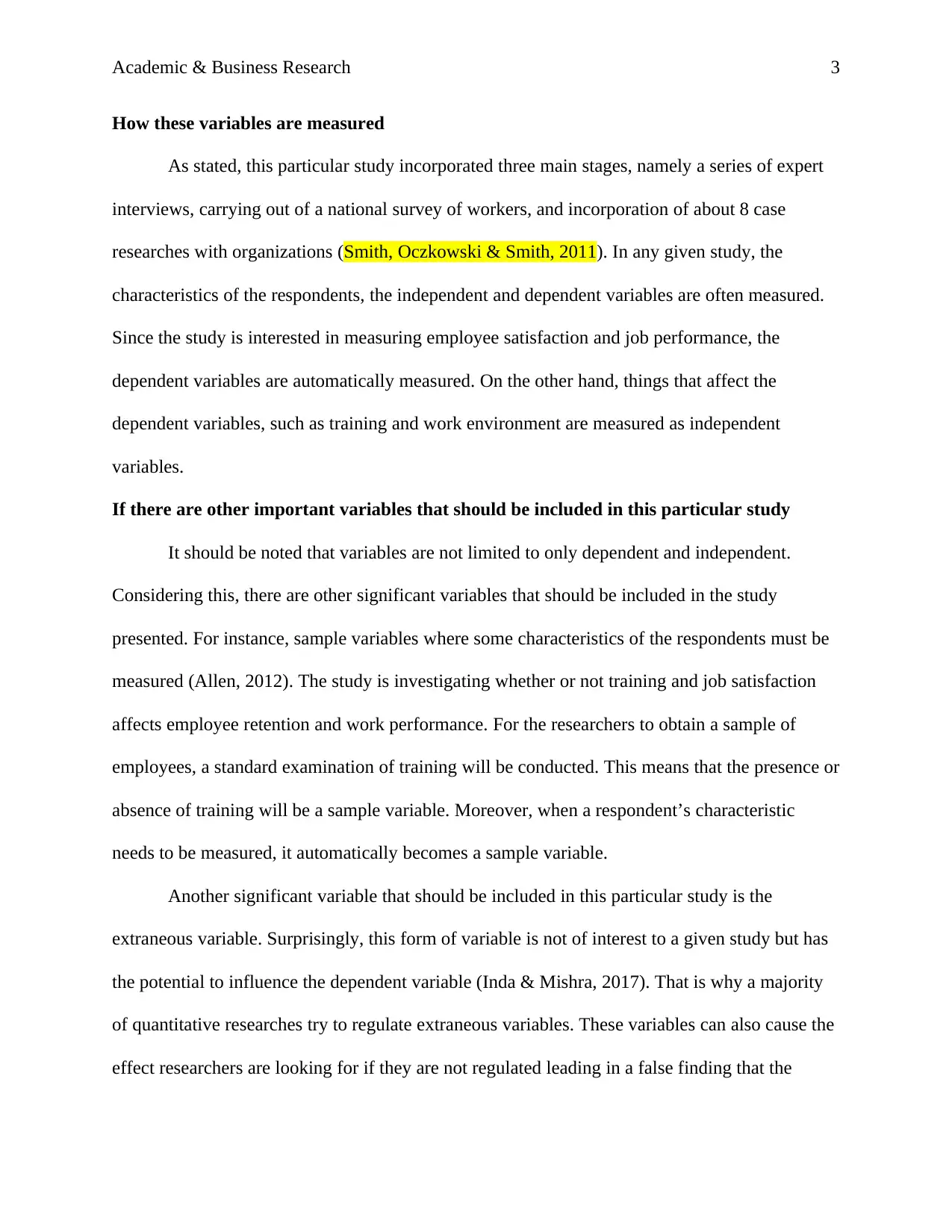
Academic & Business Research 3
How these variables are measured
As stated, this particular study incorporated three main stages, namely a series of expert
interviews, carrying out of a national survey of workers, and incorporation of about 8 case
researches with organizations (Smith, Oczkowski & Smith, 2011). In any given study, the
characteristics of the respondents, the independent and dependent variables are often measured.
Since the study is interested in measuring employee satisfaction and job performance, the
dependent variables are automatically measured. On the other hand, things that affect the
dependent variables, such as training and work environment are measured as independent
variables.
If there are other important variables that should be included in this particular study
It should be noted that variables are not limited to only dependent and independent.
Considering this, there are other significant variables that should be included in the study
presented. For instance, sample variables where some characteristics of the respondents must be
measured (Allen, 2012). The study is investigating whether or not training and job satisfaction
affects employee retention and work performance. For the researchers to obtain a sample of
employees, a standard examination of training will be conducted. This means that the presence or
absence of training will be a sample variable. Moreover, when a respondent’s characteristic
needs to be measured, it automatically becomes a sample variable.
Another significant variable that should be included in this particular study is the
extraneous variable. Surprisingly, this form of variable is not of interest to a given study but has
the potential to influence the dependent variable (Inda & Mishra, 2017). That is why a majority
of quantitative researches try to regulate extraneous variables. These variables can also cause the
effect researchers are looking for if they are not regulated leading in a false finding that the
How these variables are measured
As stated, this particular study incorporated three main stages, namely a series of expert
interviews, carrying out of a national survey of workers, and incorporation of about 8 case
researches with organizations (Smith, Oczkowski & Smith, 2011). In any given study, the
characteristics of the respondents, the independent and dependent variables are often measured.
Since the study is interested in measuring employee satisfaction and job performance, the
dependent variables are automatically measured. On the other hand, things that affect the
dependent variables, such as training and work environment are measured as independent
variables.
If there are other important variables that should be included in this particular study
It should be noted that variables are not limited to only dependent and independent.
Considering this, there are other significant variables that should be included in the study
presented. For instance, sample variables where some characteristics of the respondents must be
measured (Allen, 2012). The study is investigating whether or not training and job satisfaction
affects employee retention and work performance. For the researchers to obtain a sample of
employees, a standard examination of training will be conducted. This means that the presence or
absence of training will be a sample variable. Moreover, when a respondent’s characteristic
needs to be measured, it automatically becomes a sample variable.
Another significant variable that should be included in this particular study is the
extraneous variable. Surprisingly, this form of variable is not of interest to a given study but has
the potential to influence the dependent variable (Inda & Mishra, 2017). That is why a majority
of quantitative researches try to regulate extraneous variables. These variables can also cause the
effect researchers are looking for if they are not regulated leading in a false finding that the
⊘ This is a preview!⊘
Do you want full access?
Subscribe today to unlock all pages.

Trusted by 1+ million students worldwide
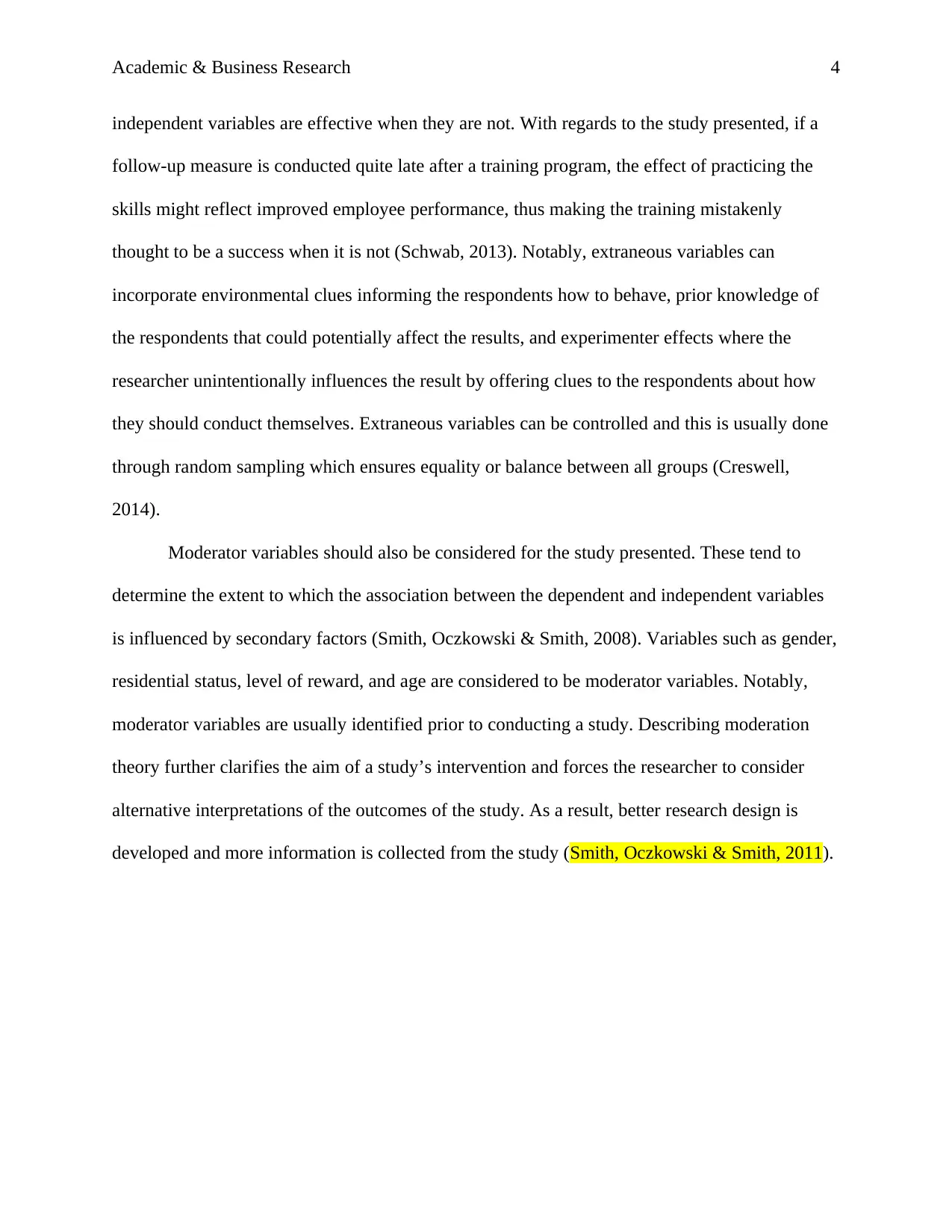
Academic & Business Research 4
independent variables are effective when they are not. With regards to the study presented, if a
follow-up measure is conducted quite late after a training program, the effect of practicing the
skills might reflect improved employee performance, thus making the training mistakenly
thought to be a success when it is not (Schwab, 2013). Notably, extraneous variables can
incorporate environmental clues informing the respondents how to behave, prior knowledge of
the respondents that could potentially affect the results, and experimenter effects where the
researcher unintentionally influences the result by offering clues to the respondents about how
they should conduct themselves. Extraneous variables can be controlled and this is usually done
through random sampling which ensures equality or balance between all groups (Creswell,
2014).
Moderator variables should also be considered for the study presented. These tend to
determine the extent to which the association between the dependent and independent variables
is influenced by secondary factors (Smith, Oczkowski & Smith, 2008). Variables such as gender,
residential status, level of reward, and age are considered to be moderator variables. Notably,
moderator variables are usually identified prior to conducting a study. Describing moderation
theory further clarifies the aim of a study’s intervention and forces the researcher to consider
alternative interpretations of the outcomes of the study. As a result, better research design is
developed and more information is collected from the study (Smith, Oczkowski & Smith, 2011).
independent variables are effective when they are not. With regards to the study presented, if a
follow-up measure is conducted quite late after a training program, the effect of practicing the
skills might reflect improved employee performance, thus making the training mistakenly
thought to be a success when it is not (Schwab, 2013). Notably, extraneous variables can
incorporate environmental clues informing the respondents how to behave, prior knowledge of
the respondents that could potentially affect the results, and experimenter effects where the
researcher unintentionally influences the result by offering clues to the respondents about how
they should conduct themselves. Extraneous variables can be controlled and this is usually done
through random sampling which ensures equality or balance between all groups (Creswell,
2014).
Moderator variables should also be considered for the study presented. These tend to
determine the extent to which the association between the dependent and independent variables
is influenced by secondary factors (Smith, Oczkowski & Smith, 2008). Variables such as gender,
residential status, level of reward, and age are considered to be moderator variables. Notably,
moderator variables are usually identified prior to conducting a study. Describing moderation
theory further clarifies the aim of a study’s intervention and forces the researcher to consider
alternative interpretations of the outcomes of the study. As a result, better research design is
developed and more information is collected from the study (Smith, Oczkowski & Smith, 2011).
Paraphrase This Document
Need a fresh take? Get an instant paraphrase of this document with our AI Paraphraser
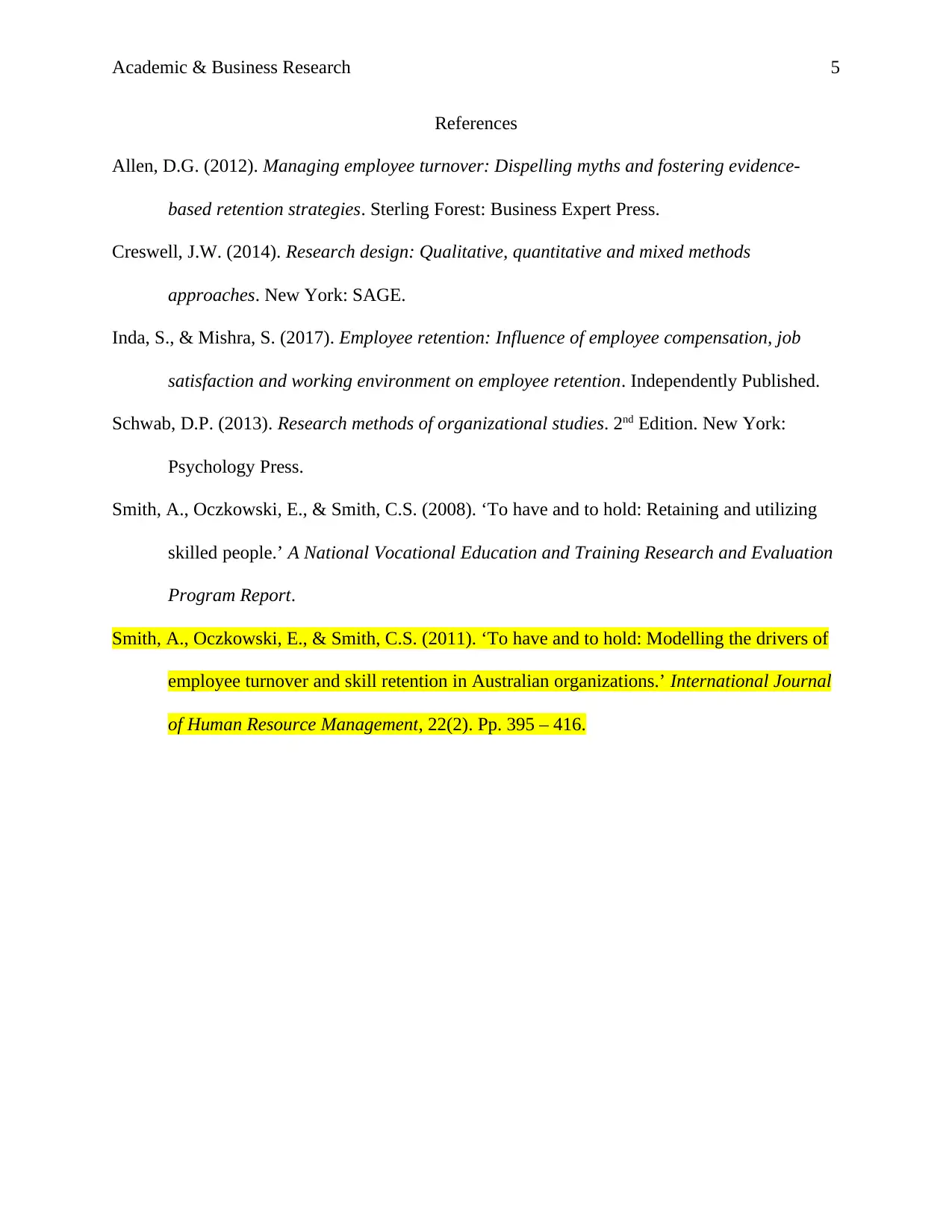
Academic & Business Research 5
References
Allen, D.G. (2012). Managing employee turnover: Dispelling myths and fostering evidence-
based retention strategies. Sterling Forest: Business Expert Press.
Creswell, J.W. (2014). Research design: Qualitative, quantitative and mixed methods
approaches. New York: SAGE.
Inda, S., & Mishra, S. (2017). Employee retention: Influence of employee compensation, job
satisfaction and working environment on employee retention. Independently Published.
Schwab, D.P. (2013). Research methods of organizational studies. 2nd Edition. New York:
Psychology Press.
Smith, A., Oczkowski, E., & Smith, C.S. (2008). ‘To have and to hold: Retaining and utilizing
skilled people.’ A National Vocational Education and Training Research and Evaluation
Program Report.
Smith, A., Oczkowski, E., & Smith, C.S. (2011). ‘To have and to hold: Modelling the drivers of
employee turnover and skill retention in Australian organizations.’ International Journal
of Human Resource Management, 22(2). Pp. 395 – 416.
References
Allen, D.G. (2012). Managing employee turnover: Dispelling myths and fostering evidence-
based retention strategies. Sterling Forest: Business Expert Press.
Creswell, J.W. (2014). Research design: Qualitative, quantitative and mixed methods
approaches. New York: SAGE.
Inda, S., & Mishra, S. (2017). Employee retention: Influence of employee compensation, job
satisfaction and working environment on employee retention. Independently Published.
Schwab, D.P. (2013). Research methods of organizational studies. 2nd Edition. New York:
Psychology Press.
Smith, A., Oczkowski, E., & Smith, C.S. (2008). ‘To have and to hold: Retaining and utilizing
skilled people.’ A National Vocational Education and Training Research and Evaluation
Program Report.
Smith, A., Oczkowski, E., & Smith, C.S. (2011). ‘To have and to hold: Modelling the drivers of
employee turnover and skill retention in Australian organizations.’ International Journal
of Human Resource Management, 22(2). Pp. 395 – 416.
1 out of 5
Related Documents
Your All-in-One AI-Powered Toolkit for Academic Success.
+13062052269
info@desklib.com
Available 24*7 on WhatsApp / Email
![[object Object]](/_next/static/media/star-bottom.7253800d.svg)
Unlock your academic potential
Copyright © 2020–2025 A2Z Services. All Rights Reserved. Developed and managed by ZUCOL.





